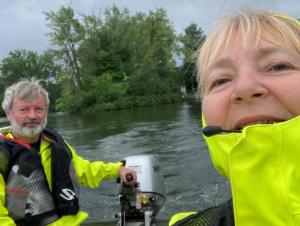

written by Alexander Karatayev and Lyubov Burlakova
This August, we collected benthic samples in Oneida Lake, which is the largest and best studied inland lake in New York State, with a strong regional, economic, and recreational importance. Frank Collins Baker, a prominent malacologist, conducted one of the world’s first quantitative benthic studies in 1915–1917, finding that Oneida Lake supported the most diverse molluscan communities in the state. Baker provided a very thorough description of his study in two books (Baker 1916, 1918) and several papers. Subsequent studies replicating Baker’s sampling design were conducted at the peak of eutrophication in 1967 (Harman and Forney 1970), and shortly after the invasion of Dreissena in 1991 (Harman 2000) in 1992–95. This produced a unique historical dataset enabling a rigorous assessment of changes in the structure and species richness of the molluscs.
In 2012, we conducted a detailed historical analysis of the mollusc community of Oneida Lake based on our comprehensive lakewide study that year and previous surveys dating back to 1915 (Karatayev et al. 2014). In the early 20th century, the lake had high water clarity, with abundant macrophytes and benthic algae, and supported a diverse molluscan community with 32 gastropod and 9 unionid species. By the 1960s, lake turbidity increased during a period of anthropogenic eutrophication, resulting in a 38% decline in species richness and a 95% reduction in abundance of native gastropods grazing on benthic algae. Following the invasion of Dreissena spp. in 1991 and subsequent increases in water clarity, gastropods in the lake dramatically increased, and by 2012 their species richness and abundance reached levels similar to those reported in 1915–1917. In contrast, filter-feeding unionids were unaffected by increased turbidity during the period of eutrophication but were extirpated by dreissenids.
In 2014, another exotic species was found in Oneida Lake. Round gobies are a bottom-feeder fish from Eurasia known to feed on molluscs and may change their community composition, abundance, and distribution. In August, to investigate their impacts on Oneida Lake molluscs, we conducted a detailed survey of molluscs of the lower South Bay, the best studied part of Oneida Lake, and collected over a hundred samples. Our 2022 sampling design repeats 2012 studies and we hope it will assess the impacts of round goby on the mollusc community. During the 2023 field season, we are planning to expand our survey to the whole lake.
Image caption: Sasha Karatayev and Lyuba Burlakova sampling Oneida Lake on a rainy day in August 2022.
Some content on this page is saved in PDF format. To view these files, download Adobe Acrobat Reader free. If you are having trouble reading a document, request an accessible copy of the PDF or Word Document.
